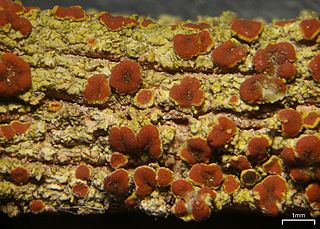Neobrownliella brownlieae is a species of saxicolous (rock-dwelling), crustose lichen in the family Teloschistaceae. It is widely distributed in Australia.
Lecanora ussuriensis is a species of saxicolous (rock-dwelling) lichen in the family Lecanoraceae. It is found in single localities in the Primorsky Krai region of the Russian Far East, as well as in Japan.

Pyrenodesmia is a genus of lichen-forming fungi in the family Teloschistaceae. The genus currently includes 23 recognized species but is believed to contain many more unnamed taxa. The genus was circumscribed in 1852 by Italian lichenologist Abramo Bartolommeo Massalongo. It is characterised by the complete absence of anthraquinones and the presence of Sedifolia-gray pigments in both the thallus and apothecia. These lichens are typically found in calcareous outcrops in the Northern Hemisphere, with biodiversity centres in the Mediterranean basin, Central Asia, and arid regions of western North America.
Neobrownliella is a genus of crustose lichens in the subfamily Teloschistoideae of the family Teloschistaceae. It has five species. The genus was circumscribed in 2015 by lichenologists Sergey Kondratyuk, Jack Elix, Ingvar Kärnefelt, and Arne Thell, with Neobrownliella brownlieae assigned as the type species. It is a segregate of the large genus Caloplaca. Characteristics of Neobrownliella include a thallus that is continuous or areolate, the presence of anthraquinones as lichen products, a cortical layer with a palisade paraplectenchyma, and the lack of a thick palisade cortical layer on the underside of the thalline exciple. Two species were included in the original circumscription of the genus; an additional three species were added in 2020.
Kashiwadia is a genus of lichen-forming fungi in the family Physciaceae. The genus was circumscribed in Sergey Kondratyuk, László Lőkös, and Jae-Seoun Hur in 2014 to contain the species Physcia orientalis, after molecular phylogenetic analysis showed that the taxon occupied an isolated phylogenetic position in the Physciaceae. An additional five species were added to the genus in 2021. The genus name honours Japanese lichenologist Hiroyuki Kashiwadani, who originally described the type species.
Tassiloa is a genus of lichen-forming fungi in the family Teloschistaceae. It has two species.
Teuvoahtiana is a genus of lichen-forming fungi in the family Teloschistaceae. It contains three species of saxicolous (rock-dwelling), crustose lichens, all of which occur in South America.
Elixjohnia is a genus of lichen-forming fungi in the family Teloschistaceae. It has four species of saxicolous (rock-dwelling), crustose lichens that occur in Australasia.

Opeltia is a genus of lichen-forming fungi in the family Teloschistaceae. It has four species of corticolous (bark-dwelling), crustose lichens.
Fauriea is a genus of lichen-forming fungi in the family Teloschistaceae. The genus, which contains seven species, is a member of the subfamily Caloplacoideae.
Marchantiana is a genus of lichen-forming fungi in the family Teloschistaceae. It contains seven species of corticolous (bark-dwelling), crustose lichens that occur in the Southern Hemisphere.
Eilifdahlia is a genus of lichen-forming fungi in the family Teloschistaceae. It contains three species of corticolous (bark-dwelling), crustose lichens that occur in the Southern Hemisphere.
Hosseusiella is a genus of lichen-forming fungi in the family Teloschistaceae. It has three species of crustose to foliose (leafy) lichens, some of which grow on bark, while others grow on rock. All three occur in the southern part of the South American continent, where they are fairly common.
Rehmanniella is a genus of lichen-forming fungi in the family Teloschistaceae. It contains five species of saxicolous (rock-dwelling) crustose lichens. The genus was circumscribed by lichenologists Sergey Kondratyuk and Jae-Seoun Hur in 2018. The genus name honours Polish geographer, geomorphologist, botanist and explorer Anton Rehmann (1840–1917), who collected bryophytes and vascular plants in South Africa. The genus was originally circumscribed with Rehmanniella wirthii assigned as the type and only species. Four additional species were added to the genus in 2020.
Orientophila is a genus of lichen-forming fungi in the family Teloschistaceae. It has 15 species of mostly saxicolous (rock-dwelling), crustose lichens. All Orientophila species occur in Northeast Asia including China, Japan, South Korea, and the Russian Far East.
Pisutiella is a genus of lichen-forming fungi in the family Teloschistaceae. It contains five species of saxicolous (rock-dwelling), crustose lichens that are found in a variety of environments in the Northern Hemisphere.
Olegblumia is a monotypic fungal genus in the family Teloschistaceae. It contains the single species Olegblumia demissa, a saxicolous (rock-dwelling) crustose lichen.
Xanthaptychia is a genus of lichen-forming fungi in the family Teloschistaceae. The genus, circumscribed in 2017, has three corticolous (bark-dwelling) species.
Franwilsia is a genus of lichen-forming fungi in the family Teloschistaceae. It has three species.
Upretia is a genus of lichen-forming fungi in the family Teloschistaceae. It has three species of saxicolous (rock-dwelling), crustose lichens. Upretia is characterised by its small ascospores and narrow, rod-shaped conidia. The distribution of the genus ranges from mid-altitude rocky terrains in India to both arid and higher altitudinal environments in China.

